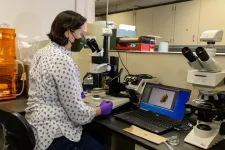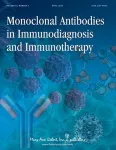(Press-News.org) In the shadow of Washington State’s Mount Rainier, about 90,000 people live in the path of a potential large lahar—a destructive, fluid and fast-moving debris flow associated with volcanic slopes.
At the Seismological Society of America (SSA)’s 2024 Annual Meeting, U.S. Geological Survey volcano seismologist Seth Moran described how he and his colleagues have expanded and made upgrades to a detection system that would inform alerts to those living near the Seattle-area volcano in the event of the next lahar.
Volcanic eruptions usually cause lahars by rapidly melting snow and ice. But rarely they can also occur under non-eruptive conditions, such as when the rock underlying a part of the volcanic edifice has been sufficiently weakened by past eruptions and then spontaneously fails, leading to a landslide that can transform into a lahar.
Large Mount Rainier lahars have flowed as far as the Puget Lowlands—about 50 kilometers distance—at least 11 times in the past 6000 years. The largest and most fluid lahars can flow over 100 miles per hour on Mount Rainier’s steep slopes, and as fast as 15 to 20 miles per hour over the Puget Lowlands.
“All of the lahars that have come down into the Puget Lowlands in the last 6000 years have started with an eruption except for the most recent one around 1507,” said Moran. The most recent lahar, known as the Electron Mudflow, appears to have started with a landslide, and researchers have found no evidence of an associated eruption.
The Mount Rainier Lahar Detection System was established in 1998 to give downstream communities tens of minutes of warning on the next large lahar. It consists of tens of seismometers and other instruments placed on the volcano’s slopes and vulnerable lahar paths such as the Puyallup and Tahoma Creek drainages.
The original system “was designed to have low bandwidth and low power requirements due to the limitations of 1990s-era technology, and that meant that data was only transmitted every two minutes,” explained Moran. The seismometer data was paired with a system of tripwires, and both the seismic signals and the tripwire signals had to be triggered over multiple time windows to engage the detection system.
“That meant there was at least four minutes of delay between when the lahar had gone past and when the system said, ‘hey, a lahar has gone past,’” Moran said.
Since 2016, the system has been updated with additional and newer instruments, including broadband seismometers transmitting real-time data continuously, new infrasound sensors, and webcams. Laser range finders are also being tested for possible future inclusion into the detection system as an alternative to tripwires.
There aren’t a lot of examples of lahars around the world that have been recorded on nearby stations, Moran explained, “so we’re not 100 percent certain that we can count on a single type of instrument to tell us what’s going on.”
The diversity of instruments also helps scientists determine whether a seismic signal received from one of the stations is really from a lahar, and not from an eruption or an earthquake. Infrasound instruments, for instance, would be able to tell the researchers that there was a disturbance at ground surface rather than deeper in the earth.
The result of the 20-year technology improvement effort has been a robust lahar detection system that operates in real time, sending detection information to two emergency operations centers that are staffed 24/7, one run by the state of Washington and one run by Pierce County. The operations centers then use the detection report to decide on and deliver a warning.
END
Lahar detection system upgraded for mount rainier
2024-05-03
ELSE PRESS RELEASES FROM THIS DATE:
NCSA's Bill Gropp elected to AAAS Council
2024-05-03
The American Association for the Advancement of Science (AAAS) is the world’s largest multidisciplinary scientific society. Its mission is to “Advance science, engineering, and innovation throughout the world for the benefit of all.” The AAAS publishes a number of prestigious scientific journals through their Science family of titles. The organization recently held elections for its leadership positions. This year, NCSA’s director, Bill Gropp, was elected as Council Member of the Section on Information, Computing, and Communication.
Gropp began his term on March 15 and will continue to serve as Council Member for the remainder ...
George Mason University receives over $1.1 million to revolutionize Lyme disease testing
2024-05-02
George Mason University researchers have received a $1,176,645 grant in federal funding from the U.S. Department of the Army to revolutionize Lyme disease detection and diagnosis with urine testing. The College of Science and College of Public Health aim to harness the many advantages of urine testing over other methods and increase mainstream adoption.
“We have developed a urine test for Lyme disease that detects the bacteria (Borrelia species) that causes Lyme disease, making it a direct test to confirm ...
NASA selects BAE systems to develop air quality instrument for NOAA
2024-05-02
NASA, on behalf of the National Oceanic and Atmospheric Administration (NOAA), has selected BAE Systems (formerly known as Ball Aerospace & Technologies Corporation) of Boulder, Colorado, to develop an instrument to monitor air quality and provide information about the impact of air pollutants on Earth for NOAA’s Geostationary Extended Observations (GeoXO) satellite program.
This cost-plus-award-fee contract is valued at approximately $365 million. It includes the development of one ...
For microscopic organisms, ocean currents act as 'expressway' to deeper depths, study finds
2024-05-02
PROVIDENCE, R.I. [Brown University] — Some of the ocean’s tiniest organisms get swept into underwater currents that act as a conduit that shuttles them from the sunny surface to deeper, darker depths where they play a huge role in affecting the ocean’s chemistry and ecosystem, according to new research.
Published in the Proceedings of the National Academy of Sciences and based on fieldwork during three research cruises spanning 2017 to 2019, the study focuses on subtropical regions in the Mediterranean Sea. It uncovered how some microscopic single-celled organisms that are too light to ...
Rice’s Harvey, Ramesh named to National Academy of Sciences
2024-05-02
HOUSTON – (May 2, 2024) – Rice University’s Ramamoorthy Ramesh and Frank Reese Harvey are among 120 new U.S. members elected to the National Academy of Sciences (NAS) “in recognition of their distinguished and continuing achievements in original research,” according to a statement from the organization.
Members are elected by their peers based on their contribution to one of six areas of scientific inquiry following an extensive vetting process. Established in 1863 through an act of Congress, NAS serves as a source of independent, objective advice on science ...
Oil palm plantations are driving massive downstream impact to watershed
2024-05-02
AMHERST, Mass. – The global demand for palm oil—the most widely consumed vegetable oil on the planet, in everything from instant noodles to lipstick—is driving worldwide tropical deforestation. While many studies have shown the loss of biodiversity when rainforests are converted to oil palm plantations, researchers at the University of Massachusetts of Amherst are the first to show far-reaching and wide-ranging disturbances to the watersheds in which such plantations occur. Because many Indigenous peoples rely on water downstream from the plantations for their daily needs, the marked decrease in water quality has ...
Nanotubes, nanoparticles, and antibodies detect tiny amounts of fentanyl
2024-05-02
A research team at Pitt led by Alexander Star, a chemistry professor in the Kenneth P. Dietrich School of Arts and Sciences, has developed a fentanyl sensor that is six orders of magnitude more sensitive than any electrochemical sensor for the drug reported in the past five years. The portable sensor can also tell the difference between fentanyl and other opioids.
Their work was published in the journal Small.
Fentanyl is a synthetic opioid and one of the main drivers in overdose deaths in the United States, Star said. It’s often mixed with other drugs, but because ...
New eco-friendly lubricant additives protect turbine equipment, waterways
2024-05-02
Scientists at the Department of Energy’s Oak Ridge National Laboratory have developed lubricant additives that protect both water turbine equipment and the surrounding environment.
Each year, roughly 2.47 billion gallons of lubricating oil are consumed in the United States alone for engines and industrial machinery, according to DOE, with about half eventually finding its way into the environment.
While environmentally acceptable lubricants are available, they are not optimized with additives that can greatly improve performance while posing minimal environmental impact if accidentally released. To create nontoxic, biodegradable and high-performing lubricant ...
Monoclonal Antibodies in Immunodiagnosis and Immunotherapy appoints new Deputy Editor-in-Chief, Andrei Moroz, PhD
2024-05-02
Mary Ann Liebert, Inc., is pleased that Andrei Moroz, PhD, has been appointed the new Deputy Editor-in-Chief of the bimonthly journal Monoclonal Antibodies in Immunodiagnosis and Immunotherapy. Dr. Moroz is joining Cory Brooks, PhD, as part of the senior editorial leadership team for the journal.
Monoclonal Antibodies in Immunodiagnosis and Immunotherapy is a peer-reviewed venue for promoting and sharing research rooted in hybridoma technology. It aims at advancing the understanding of the biology and immunology that underscores the utility of antibodies as diagnostics and therapeutics. The journal publishes ...
Optical pumped magnetometer magnetocardiography as a potential method of therapy monitoring in fulminant myocarditis
2024-05-02
https://www.scienceopen.com/hosted-document?doi=10.15212/CVIA.2024.0031
Announcing a new article publication for Cardiovascular Innovations and Applications journal. Fulminant myocarditis (FM) is associated with high mortality and an unfavorable long-term prognosis. However, noninvasive, rapid diagnostic and monitoring methods for FM are lacking.
This article details the case of a patient diagnosed with FM through a comprehensive assessment involving typical clinical symptoms, laboratory analyses, echocardiographic evidence, and cardiac magnetic resonance (CMR) findings. Before the patient underwent CMR, optical pumped magnetometer magnetocardiography (OPM-MCG) revealed abnormalities characteristic ...






